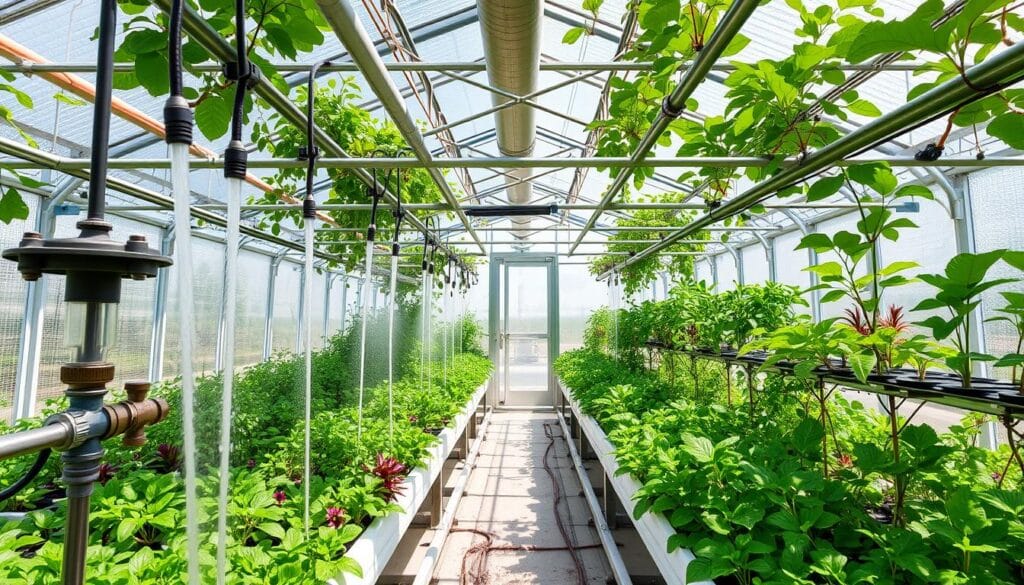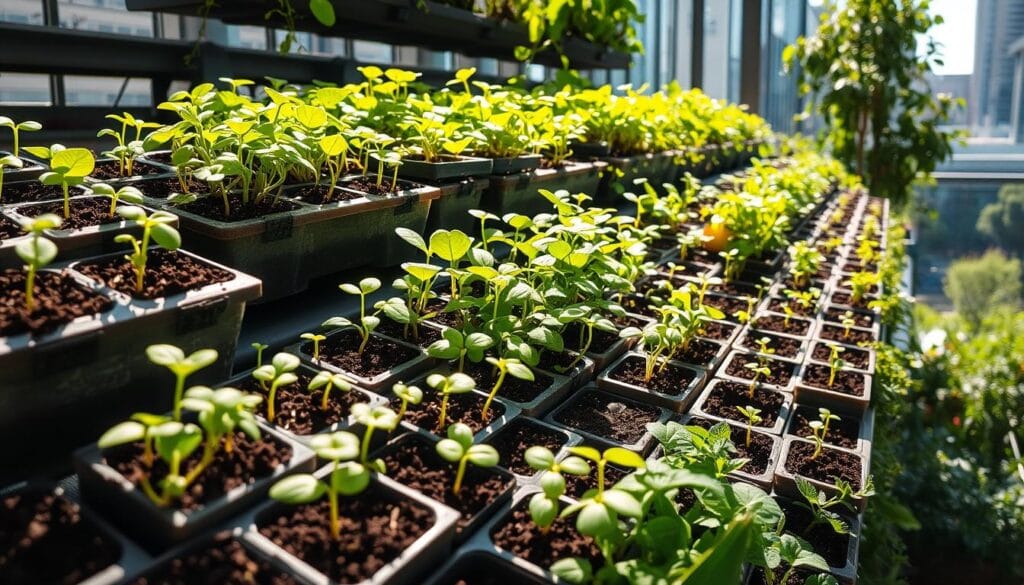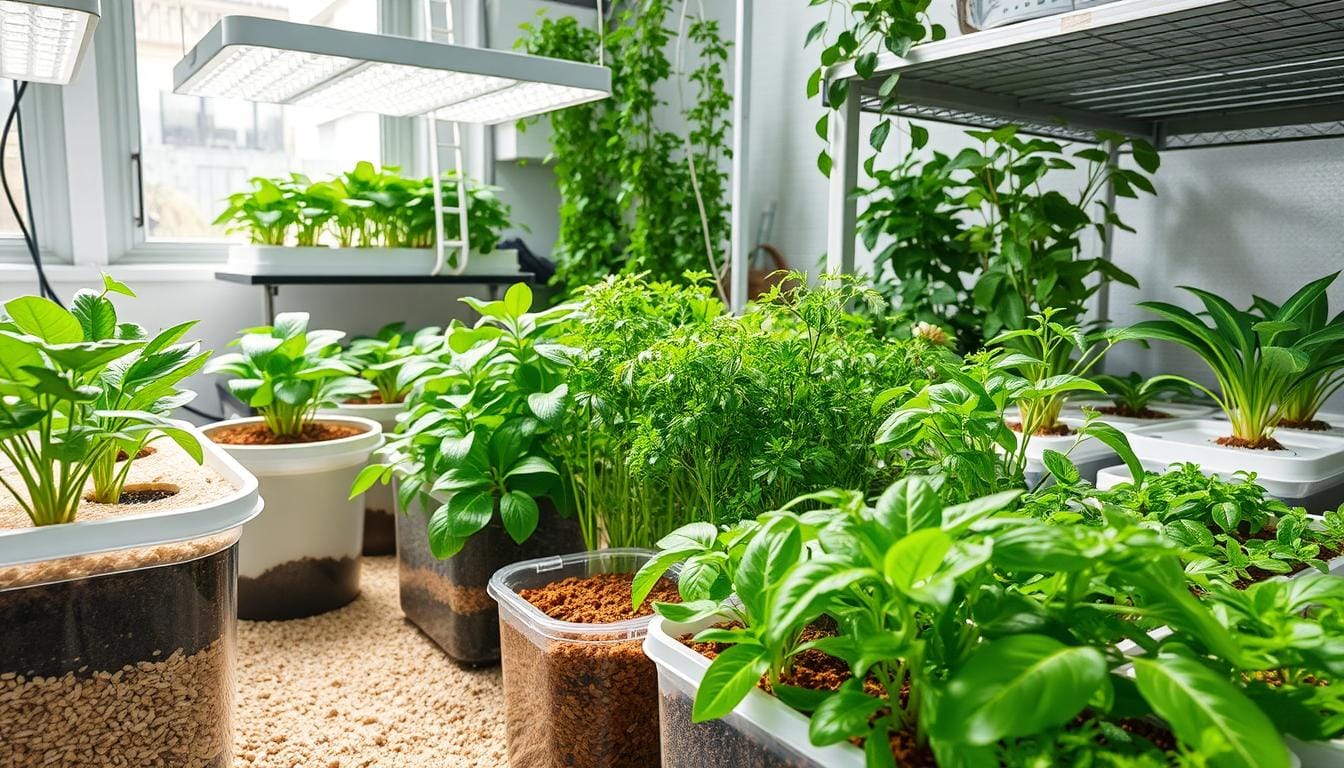I love indoor gardening and the magic of soilless growing media. These innovative methods of growing plants without soil allow us to control every aspect of plant growth. Whether you’re a beginner or an experienced gardener, learning to work with soilless growing media opens up a world of possibilities. Properly using soilless growing media can help your plants grow stronger and healthier, providing a more controlled environment for optimal growth.
Key Takeaways
- Soilless growing media give us more control over growing conditions, nutrients, and pH levels for better plant growth.
- Knowing the benefits and uses of different hydroponic systems is key for indoor gardening success.
- Choosing and managing growing media well is vital for healthy, productive plants.
- Nutrient management, watering, and environmental control are crucial for thriving soilless gardens.
- Staying away from mistakes like overfeeding and poor environment control is important for your indoor garden’s long-term success.
Understanding Soilless Media Fundamentals
If you’re starting with indoor gardening, knowing about soilless growing media is key. These substrates offer many benefits over traditional soil. They come in various types, from hydroponic systems to potting mixes, each suited for different needs.
Types of Growing Media Available
Soilless media include peat moss, coco coir, perlite, vermiculite, and coarse sand. Peat moss holds moisture and improves air flow. Coco coir is eco-friendly and keeps moisture well. Perlite and vermiculite help with drainage and air. Coarse sand adds density and structure.
Benefits of Soilless Growing
Soilless growing has many advantages. Hydroponics, like DWC and NFT, skip soil and feed plants directly. This leads to quicker growth and better resource use. It also cuts down on soil diseases. Plus, these systems can be set up to control light, temperature, and humidity perfectly for plants.
Key Components of Success
Success with soilless media depends on several key factors. Nutrient management, pH control, and environmental monitoring are vital. Using slow-release fertilizers and changing nutrient solutions regularly is important. Monitoring temperature, humidity, and oxygen levels helps create the best growing environment for plants.
| Soilless Media | Key Benefits |
|---|---|
| Peat Moss | Retains moisture, improves aeration |
| Coco Coir | Environmentally-friendly, moisture-retaining |
| Perlite | Enhances drainage and aeration |
| Vermiculite | Retains moisture and fertilizer, improves aeration |
| Coarse Sand | Enhances drainage and density |
Understanding soilless media helps indoor gardeners get the most from their grow lights and systems. The right mix and attention to environmental factors lead to healthy plants and good harvests. This approach also reduces the problems of traditional soil gardening.
Selecting the Right Indoor Gardening Media
Choosing the right soilless media is key for indoor gardening success. It depends on your plants, space, and gardening level.
For new gardeners, systems like Deep Water Culture (DWC) or Wick Systems are great. They’re easy to use for starting seeds and growing plants vertically. You can grow everything from leafy greens to herbs and small veggies.
As you get better, you might want to try more complex systems. Nutrient Film Technique (NFT) or Aeroponics offer better control. They’re good for plants needing specific nutrients or conditions, like tomatoes or peppers.
Think about what your plants need. Some like it humid, others dry. Ferns, Peperomia, and African violets love humidity, while succulents and cacti prefer dry air.
Also, know how much light your plants need. Spider plants, Aloe vera, and Rubber plants need lots of light. But Snake plants and ZZ plants do well in low light. The right media ensures your plants grow well and produce a lot.
Other things to consider are your budget and space. Look into peat, coco coir, rockwool, and expanded clay pebbles. Each has its own benefits and costs. Making an informed choice helps your indoor garden thrive, no matter your skill level.
Essential Nutrient Management for Soilless Systems
Proper nutrient management is key for plants in soilless media. Unlike soil gardening, hydroponics and soil alternatives need a balanced nutrient mix. Knowing how to manage nutrients unlocks your soilless system’s full potential.
Macro and Micronutrient Balance
Soilless mixes combine organic and inorganic materials like coconut coir and perlite. These materials help plants grow well. Coconut coir, for example, holds water and air well.
Soilless mixes control nutrient levels and pH better than soil. This ensures plants get the right nutrients. It prevents nutrient problems and boosts plant health.
pH Monitoring and Adjustment
Keeping the pH right is vital in soilless systems. Aim for a pH of 5.5 to 6.5 for best nutrient uptake. Check your solution’s pH often and adjust as needed.
Water alkalinity can upset pH. Use reverse osmosis water for a stable pH. This helps prevent nutrient issues and supports plant growth.
Feeding Schedules and Solutions
Plan feeding schedules based on plant growth and needs. Use hydroponic nutrient solutions for balanced nutrients.
Check the EC and pH of your solution and runoff. Aim for 25-30% runoff to avoid salt buildup. This ensures your plants get nutrients well.
Mastering nutrient management in soilless systems leads to great plant growth. Consistent monitoring and understanding plant needs are crucial. Success in hydroponics and soil alternatives depends on it.
Water Management and Irrigation Techniques
Managing water well is key to growing plants successfully without soil. When using indoor gardening media, you need the right irrigation methods. These can be drip systems, flood and drain, or misting, based on your irrigation systems needs.
It’s also important to keep the nutrient solution well-oxygenated and at the right temperature. You should check and adjust the water levels and quality often. This supports proper growth and ensures plants remain healthy.
- Choose the best irrigation system for your indoor gardening media, like drip, flood and drain, or misting.
- Make sure the nutrient solution has enough oxygen for the roots to grow.
- Keep an eye on the water temperature to ensure it’s good for plant growth.
- Check and tweak the water levels and quality regularly to avoid problems like nutrient shortages or toxicity.
“Efficient water management is the foundation of a thriving soilless growing operation.”
By carefully managing your water and irrigation, you’ll see great results with your indoor gardening media. This will help you get the most out of your soilless growing projects.

Environmental Control for Optimal Growth
Controlling the environment is key for growing healthy plants indoors. You need to manage temperature, humidity, air flow, and light. This setup helps plants grow well and stay healthy.
Temperature and Humidity Requirements
Keep your plants in a temperature range of 65°F to 80°F. Changes in temperature can stress them out. Also, keep humidity levels between 40% to 70% to avoid mold.
Ventilation and Air Circulation
Good air flow is vital for plant health. Make sure your space has enough air to keep temperatures steady. This prevents disease and promotes growth. Use fans or control systems to manage air flow.
Light Management Systems
Lighting is crucial for indoor gardening. Use grow lights to supplement natural light. This ensures plants get the right amount of light for photosynthesis.
By controlling temperature, humidity, air flow, and light, you create the best conditions for your plants. This approach helps your indoor garden flourish.
| Environmental Factor | Optimal Range | Benefits of Control |
|---|---|---|
| Temperature | 65°F to 80°F | Promotes plant growth and prevents stress |
| Humidity | 40% to 70% | Reduces risk of mold and fungal infections |
| Ventilation | Adequate air circulation | Regulates temperature and prevents stagnant air |
| Lighting | Supplemental grow lights | Ensures proper light exposure for photosynthesis |
With the right environmental control, your indoor plants will thrive. Enjoy a bountiful harvest from your grow lights or greenhouse gardening setup.
Plant Selection and Growth Monitoring
Choosing the right plants is key to success in soilless growing. Opt for plants like leafy greens, herbs, tomatoes, and strawberries. Stay away from root vegetables that need soil to grow.
Keep an eye out for signs of nutrient issues, pests, or diseases in your plants. Watch how they grow and adjust their environment and nutrients as needed. Knowing what light, temperature, and humidity your plants need is crucial for a healthy garden.
- Select plants that thrive in soilless growing media, such as leafy greens, herbs, tomatoes, and strawberries.
- Check plants regularly for indications of nutrient deficiencies, pests, or diseases.
- Monitor plant growth rates and adjust environmental conditions and nutrient delivery accordingly.
- Understand the specific light, temperature, and humidity requirements of your chosen plants.
| Plant | Pot Size Requirement | Light Needs |
|---|---|---|
| Tomatoes | 5-10 gallons | 6-8 hours of daily sunlight |
| Lettuce | 6-12 inches | 6-8 hours of daily sunlight |
| Carrots | 8 inches deep | 6-8 hours of daily sunlight |
| Herbs | 6 inches | 6-8 hours of daily sunlight |
By picking the right plants for seed starting and vertical gardens, and watching them closely, you can have a thriving indoor garden. It will give you plenty of fresh produce.

Common Mistakes to Avoid in Soilless Growing
Starting your indoor garden with soilless media can be exciting. But, it’s important to avoid common mistakes. These include overfeeding and not controlling the environment well. Fixing these issues can greatly improve your gardening success.
Overfeeding and Nutrient Burn
One big mistake is giving your plants too many nutrients. This can cause “nutrient burn,” which harms your plants. Watch how much you feed them and stick to the right amounts for your plants and media.
Poor Environmental Control
Keeping the right temperature, humidity, and air flow is key for your plants. Changes in these can stress your plants and make them sick. Use good climate control and watch your environment closely for the best results.
Inadequate System Maintenance
Not keeping your system clean can cause many problems. This includes clogged lines and algae. Check your equipment, clean water tanks, and fix problems fast to keep your garden healthy.
By avoiding these mistakes, you can grow a great indoor garden with soilless media. Paying attention and solving problems quickly are important for success in soilless gardening.
“Proper maintenance and vigilance are essential for achieving optimal results in soilless gardening.”
Advanced Growing Techniques and Tips
Explore advanced techniques in hydroponics and greenhouse gardening to boost your yields. Try vertical gardening and aquaponics to change your indoor growing game.
Vertical gardening stacks plants to save space. It also improves light and air for your plants. This method is great for small areas.
Aquaponics links hydroponics with fish farming.
It is a closed-loop system that reuses water and nutrients. This setup saves resources and offers both plants and fish.
Use automated nutrient dosing systems for better plant care. These systems adjust nutrient levels for your plants’ best growth.
Try different plant varieties and growing media combinations to find what works best for you. Adding sensors and data logging can also help improve your setup.
“The key to successful indoor gardening lies in constantly exploring new techniques and technologies to push the boundaries of what’s possible.”
Embracing these advanced methods will boost your hydroponics or greenhouse gardening success. Stay curious, experiment, and watch your indoor garden thrive.
| Technique | Benefits |
|---|---|
| Vertical Gardening | Maximizes growing space, improves light exposure, and enhances airflow. |
| Aquaponics | Creates a self-sustaining ecosystem that conserves resources and provides dual harvests of produce and seafood. |
| Automated Nutrient Dosing | Precisely monitors and adjusts nutrient levels for optimal plant growth. |
Conclusion
Learning about indoor gardening with soilless media can change your life. It opens up new possibilities for your gardening skills. By knowing the basics of different gardening media, choosing the best systems, and managing them well, you can grow amazing indoor gardens.
These gardens not only look great but also improve your health. They can make your home more beautiful and help you feel better.
As you learn more about indoor gardening media and soil alternatives, stay open to new ideas. Indoor gardening keeps changing, and being ready to try new things is key. Enjoy the journey, celebrate your wins, and don’t be scared to try new things.
It’s through trying new things that you’ll really get good at growing plants without soil. You’ll become a pro in indoor gardening.
The happiness you get from growing your own indoor garden is special. Dive into the process, enjoy the little wins, and let your love for indoor gardening media and soil alternatives take you to new levels of success and growth.

